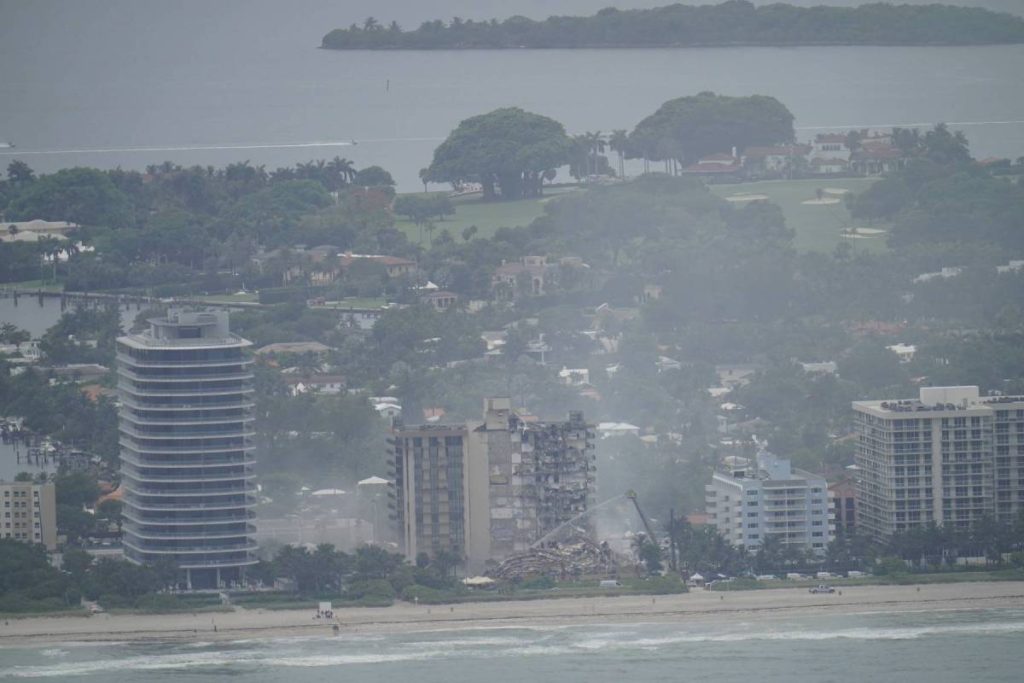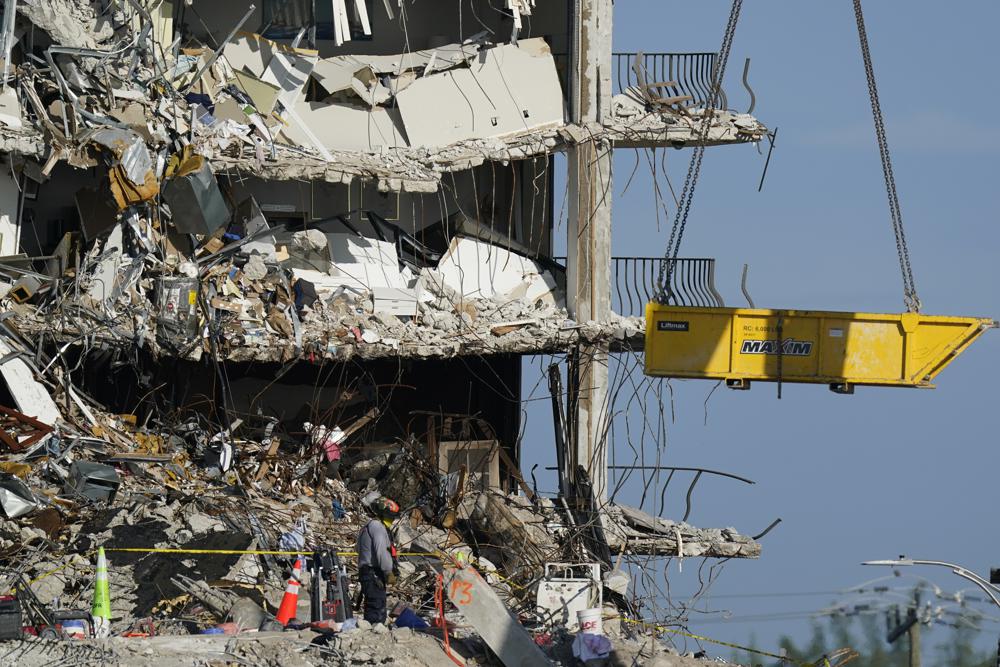Miami’s climate dystopia gets real – South Florida real estate will get more deadly if we continue to ignore the warning signs of a doomed coastline

By Jeff Goodell
1 July 2021
(Rolling Stone) – Before it fell, Champlain Towers South, the 12-story Florida condo building that collapsed last week in the middle of the night, burying residents in a pile of concrete and chaos, was just another nondescript high-rise on the beach. It had been thrown up quickly during the go-go years of the 1980s, when the deregulation of the savings and loan industry sparked a red-hot building boom in Miami. Forty years later, it was showing its age, not just in its clunky, vaguely Soviet design, but in the faded, weather-beaten look that old concrete structures get after they have been too long exposed to salty water and wind.
I know this because I used to walk by it every day. A few years ago, when I was in Miami researching and reporting The Water Will Come, a book about the risks and consequences of sea level rise, I rented a room in a house not far from Surfside, a quiet community just north of the city of Miami Beach. To clear my head, I often walked on the beach in front of Champlain Towers South. I never gave the building much thought, beyond what I think anytime I see a building close to the shore in South Florida: Someday in the not-so-distant future, this is all going to be underwater.
At the time, my eye was drawn more to a neighboring building, Eighty Seven Park, a luxurious new 20-story condo tower designed by star-architect Renzo Piano that was then under construction. The building looks like a series of platforms floating above the water, with lots of glass for spectacular views of the Atlantic (the 25,000-square-foot penthouse at the top later sold for $37 million). I used to poke my nose into the construction site and marvel at the concrete pilings and beams that were being installed to support the structure. I am not an engineer, but it looked pretty sturdy to me.
And it still does. Looking at pictures of Champlain Towers South now, after the collapse, I see a terrible juxtaposition between the two buildings: One is a pile of rubble, infused with shock and pain and grief, and the other a sleek tower where not even a beach chair looks out of place.
One truth is inescapable: 20th-century cities are not built for what’s coming at them in the 21st century. And the longer it takes for us to grasp that, and to take dramatic action to fix it, the more people will die.
As of today, there are 18 confirmed deaths in the Champlain Towers South collapse; 145 people are still unaccounted for. The rescue effort has been exceedingly dangerous and complex. The search was paused this morning when engineers detected movement in the remaining structure and feared it too could collapse. President Biden and First Lady Jill made a low-key visit to the site, where they were briefed on rescue efforts and met with families and first responders. “We’re letting the nation know we can cooperate,” Biden said, flanked by Florida Gov. Ron DeSantis and Miami-Dade County Mayor Daniella Levine Cava. “When it’s really important … This is life and death.”
In Miami, even life-and-death events turn out to be, in the end, all about real estate. Or to put it another way, your fate can be shaped by where you can afford to live. A few weeks ago, a 1,000-square-foot apartment at Eighty Seven Park was going for $2 million. In contrast, a one-bedroom condo at the Champlain Tower South could be had for about $550,000 (and up).
Both buildings had the same view. But Champlain Tower South was cheaper because it was old, and the windows weren’t as big, and the underground parking lot was often flooded, and most important of all, in the Miami hierarchy of things, it didn’t have the cache of being built by a starchitect like Renzo Piano. Still, it was a nice place. It was on the water. It was close to both downtown Miami Beach and the shopping mall in Bal Harbour.
But many of the people who lived in Champlain Tower South didn’t have a lot of money to throw around. You can see this in the careful tone of a letter Jean Wodnicki, the president of the Champlain Towers South condo association, wrote to residents a few months before the collapse, telling them that work was about to begin on the “major structural damage” that had been revealed in an inspection back in 2018, which included “abundant” cracking and spalling of the columns, beams, and walls in the parking garage under the tower. Wodnicki warned residents that damage was “accelerating” and “would begin to multiply exponentially” in coming years. Total cost for the repairs: $15 million. Depending on the size of their condo, the bill for each resident could run between $80,000 and $200,000. That may be what some Miami Beach neighbors spend on a new handbag, but for most people, it’s a lot of money.
The condo association fought for months about when to start the repairs and how to finance it. “People were quitting, and there were new people, and there was all kinds of stuff that was going on that was not pleasant,” Max Friedman, a former member of the board, told The New York Times.

In Surfside, as well as in Miami Beach and Miami-Dade County, all buildings must be inspected and re-certified when they are 40 years old. It’s not a tough test, but an engineer has to sign off on the structural integrity of a place before the city will re-certify the building. Many residents had seen cracks around the pool area and were spooked by the water in the parking garage, but it’s a fine line between “we should get this fixed” and “if we don’t get this fixed, the building may collapse.” And trusted government officials weren’t much help. Indeed, a month after the 2018 engineer’s report had flagged “major structural damage” at Champlain Towers South, the chief building official for the town of Surfside told residents the condominium was “in very good shape.”
In an eerie sort of way, the debate about fixing the building was a lot like the debate about fixing our climate: It’s all too easy to kick the can down the road, to minimize the scale of the risk we face, and to believe that even urgent warning signs can be ignored because, after all, buildings don’t just suddenly fall down and cities don’t just suddenly become uninhabitable, right? […]
Wayne Pathman, a lawyer in Miami Beach who has long pushed South Florida developers and politicians to take more dramatic action on sea-level rise, compares the collapse of the Champlain tower to Hurricane Andrew. “Just as Andrew led to a new, tougher building code, this collapse is going to bring big changes in how we inspect and certify buildings.” In Pathman’s view, there will be a much tougher re-certification process for old buildings, as well as a requirement to inspect the substructure of all buildings, perhaps by using ground-penetrating radar, sonar, or other high-tech equipment. The city of Miami Beach, whose northern border is just feet from the collapse site in Surfside, is not waiting for building owners to file engineering reports and has already begun doing visual inspections of the 507 buildings in the city that currently require 40-year recertifications. After the collapse, the city of Miami’s building department also announced it will request citywide inspections of all buildings six stories or taller that are 40 years or older. […]
It’s too early to say how transformative this tragedy will be. Right now, the focus is, rightly, on the grieving families who have lost loved ones in the collapse. There will be a federal investigation into what went wrong at Champlain Towers South, and lots of recommendations about what might be learned from all this. In the end, the role that rising waters and the climate crisis played may be unanswerable in a definitive way. But one truth is inescapable: 20th century cities are not built for what’s coming at them in the 21st century. And the longer it takes for us to grasp that, and to take dramatic action to fix it, the more people will die. [more]


